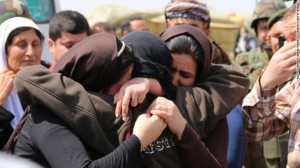
ISIS steps up use of chemicals on battlefields in Iraq and Syria
ISIS recently used devices filled with chemical agents against Kurdish forces and civilians in both Iraq and Syria, a joint investigation by two independent organizations has found.
The findings build on previous reporting that ISIS (the Islamic State in Iraq and Syria) has begun to adapt both suicide bombs and improvised explosive devices (IEDs) to include chlorine and other chemicals and may seek to exploit the use of chemicals as it develops new weapons.
The two U.K.-based groups — Conflict Armament Research (CAR) and Sahan Research — sent teams to investigate allegations that ISIS used chemical munitions on three occasions last month. Two of the incidents occurred in Hasakah province in northern Syria, where ISIS is locked in battle with the Kurdish YPG group. The third involved a 120 mm mortar that landed near Kurdish positions at the Mosul Dam in northern Iraq but failed to explode.
CAR said this was “the first documented use by (ISIS) forces of projectile-delivered chemical agents against Kurdish forces and civilian targets.”
Evidence found
James Bevan, executive director of CAR, said the group’s investigators went to the scene of the Mosul Dam attack a week after it occurred. Even then, the dark yellow liquid leaking from the mortar emitted a powerful odor. “The investigation team also experienced headaches and nausea when in close proximity to the projectile/agent,” Bevan said, symptoms consistent with exposure to a chlorine chemical agent.
The device was sent for further testing by the Kurdish Regional Government. A senior official with the Kurdish Region Security Council told CNN Sunday that they expected to confirm the device contained chlorine. The official said there had been several other instances in which ISIS had used chlorine against Kurdish Peshmerga units, and the group’s tactics were evolving.
CAR and Sahan Research also investigated the munitions that landed in northern Syria — at Tel Brak and Hasakah. Bevan said ISIS forces had “fired a whole range of projectiles at a Kurdish YPG unit outpost” on June 28th. They had caused “loss of focus; loss of consciousness in some cases; pain from the waist down, resulting in temporary, localized paralysis” and other problems.
Nine days later, when researchers examined fragments of munitions at Tel Brak, they were covered in a chemical residue which still had an acrid odor and caused powerful throat and eye irritation. At a hospital in Qamishli, several of the affected fighters tested positive for PH3, a phosphine-based chemical used as an insecticide or fumigating compound.
On the same day as the Tel Brak attack, a home in Hasakah was struck by a rocket that contained a chemical liquid whose residue was dark olive green. The projectile had been fired from a village about four kilometers away which was then under the control of ISIS, Bevan said. Again, investigating teams found residues that “emitted an acrid odor and induced powerful throat and eye irritation.”





Leave a Reply